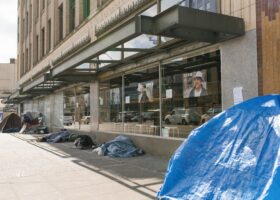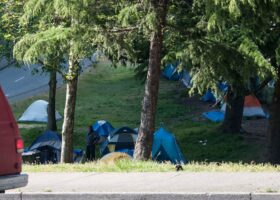Hotel California/Love Shack is not the way to shelter the homeless
July 27, 2022
We’ve long argued that the type of homelessness that we are now seeing in Seattle and King County is not the result of unaffordable housing, but a combination of mental illness, substance abuse, drug addiction, and unwillingness by those in need to accept help, combined with a lack of accountability by those who receive taxpayer dollars.
But don’t take our word for it. Just ask them.
A week ago The Seattle Times ran an article examining the life of Kanen “Gonzo” Walker, a homeless Seattle man who has wandered from one drug encampment to another before finally settling into a county-owned hotel managed by Downtown Emergency Service Center – only to land back on the street.
As The Seattle Times reports, only one out of four homeless people go to long-term housing, and Gonzo’s situation is a good summary of why: they are simply unable to care for themselves and unwilling to have any kind of ordinary restraints placed on their behavior.
Gonzo was reluctant to give up his freedom on the streets for the rules of the hotel shelter opening nearby — a former Holiday Inn now called the Mary Pilgrim Inn. But the school district is clearing the encampment’s residents and he thinks he is ready to be inside.
The homeless system has never offered Gonzo much. Better to simply go it alone outside.
The reality is most homeless like living on the street, where they are able to do whatever they want, consume legal and illegal substances they want, and others are forced to accommodate them.
Like most homeless people, Gonzo struggles with drug addiction, has a criminal record, and by all indications suffers from mental health problems.
He values his privacy and autonomy, and has been through rehab about four times but never been able to get housing, so each time he left the treatment center and returned to the street.
When the offer for shelter came at Bitter Lake, Gonzo mulled whether to say yes because of all the rules, which seemed to him like a leash.
So, for a long time Gonzo avoided seeking shelter and instead roamed from one encampment to another, occupying public spaces. What drove him to the county-owned hotel was the increased crime occurring in the encampments.
Of course, getting them off the street is just one part of the process towards reducing homelessness. But the facilities themselves need to be properly managed.
Instead, it appears to be more of a taxpayer-subsidized Hotel California for the homeless.
Baggies contain harm reduction kits of needles and straps. Over the next few months a tremendous amount of methamphetamine and fentanyl will circulate through this hotel, killing two residents.
As the article states, there are various rules for the homeless living there – rules Gonzo finds “strict” despite receiving free housing and services.
So how are drugs circulating in a county-owned hotel? Who is ensuring that this is stopped? What kind of security measures are being put in place?
The shelters need better protection because on top of drug overdoses, they also experience violence resulting from – you guessed it – homeless people suffering from mentally illness.
Rates of assault on the staff at the nonprofit’s shelters are high, and have risen since the pandemic tightened access to crisis mental health beds. The last quarter of 2021 had 56 assaults on staff, up from 39 the quarter before.
In Gonzo’s case, unlike Hotel California -where you can never leave- he was eventually kicked out.
Gonzo looks out his new window at Aurora Avenue — at the pawnshop, used car dealerships and sewer repair shop across the street.
Half a block up, next to an O’Reilly’s, an abandoned Taco Time has a paint-spattered drive-thru sign and smashed windows.
In four months, Gonzo would be sleeping in its walk-in freezer.
He met a girl sleeping down the hall at the Mary Pilgrim Inn who had a roommate she didn’t like, and he invited her over, repeatedly. It would have been a simple kindness and the start of a romance when he was living on his own, but here, broken rules.
The article doesn’t explicitly state what “broken” rules Gonzo violated, but one of the rules stated is there are to be no visitors in rooms.
Apparently, the drug-infused homeless Hotel California also plays a second role as a taxpayer subsidized Love Shack. All subsidized by taxpayers.
According to the nonprofit running the shelter, Gonzo was removed due to “acute safety issues.”
Gonzo maintains that his experience at the Mary Pilgrim Inn was the worst he’s had in shelter. He is resentful of the way the promise it offered was taken away.
And yet, if he were offered another shot?
He would take it.
It’s clear Gonzo is incapable of taking care of himself. He suffers from mental health problems, has failed rehab four times, and prefers living in squalor than to follow basic rules of a shelter.
At the same time, the shelter doesn’t sound like it’s enticing if you’re a homeless person trying to get clean and avoid the crime and violence from a drug encampment. What is being done to prevent the homeless there from overdosing? What incentives are in place for the nonprofit to get the situation under control? What is the goal of these county-owned shelters? What plan is in place to get men like Gonzo into long-term care?
Fundamentally this is an accountability issue.
The homeless aren’t held accountable.
The nonprofits that shelter them aren’t held accountable.
The public officials charged with solving this crisis aren’t held accountable.
Until that changes, the situation will remain the same.




